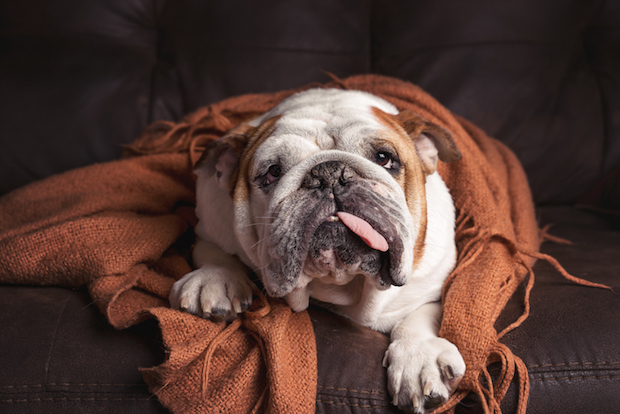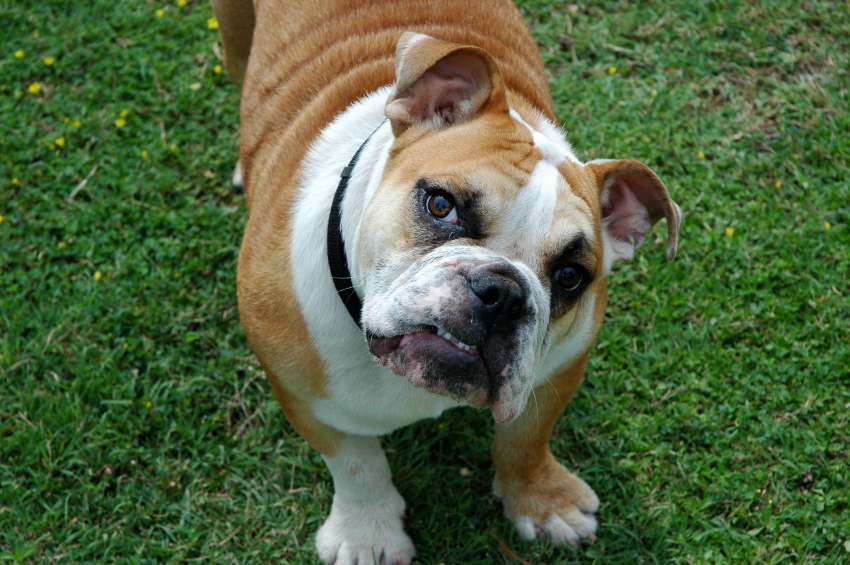Canine distemper in Bulldogs turns more severe, as these brachycephalic dogs – with the short-broad skulls that make breathing a difficult process – are prone to respiratory distress. With no direct cure, it is hard to alleviate this deadly, systemic, and contagious viral disease and about 80% of puppies and 50% of adult dogs who contract this disease die. With preventive measures in place, you can safeguard your Bulldog from this fatal disease.

What is Canine Distemper in Bulldogs?
The contagious, viral disease is caused by the canine distemper virus, which belongs to the same family of virus (paramyxoviridae) that leads to measles in humans and Newcastle disease in birds. Canine distemper can kill dogs of all ages, but unvaccinated puppies face the most serious threat. It results in severe gastrointestinal and respiratory infections that lead to secondary bacterial infections and spreads to the spinal cord and brain.
What are the Signs and Symptoms of Canine Distemper in Bulldogs?
The incubation period for canine distemper is usually 1 to 2 weeks after a Bulldog gets infected. Symptoms start to show 2 to 5 weeks after the incubation. When the virus enters your Bulldog through his nose or mouth, it travels to the lymph nodes in the lungs before getting into the bloodstream. Once the nodes are overpowered, it invades other organs and body systems.
Mucosal Phase
The mucosal stage is an early phase of canine distemper. During this phase, the virus starts attacking your Bulldog’s respiratory tract, causing yellow to green eye and nasal discharge. This symptom is very common and often mistaken as a simple respiratory infection. Your Bulldog may also experience fever sporadically. The virus then invades the gastrointestinal tract, causing your Bulldog to lose his appetite and suffer from diarrhea.
The following symptoms are visible in this phase.
- Yellowish to green eye and nasal discharge
- Pneumonia
- Loss of appetite
- Diarrhea
- Labored breathing
- Depression
- Lethargy
The mucosal phase usually lasts for a week. The said symptoms may go away and the disease may enter a “latent” stage again.
Neurological Phase
After the mucosal phase, the disease progresses to the neurological phase, in which the virus enters the central nervous system. Because the virus attacks the nerves, your Bulldog may experience severe neurological symptoms including the following.
- Head Bobbing
- Twitching of the limbs
- Seizures
- “Chewing Gum” seizure
- Blood in stool
- Hyperkeratosis (thickening) of the foot pads or nose
- Paralysis
- Coma
Your Bulldog’s footpads may also start to become hard. As the disease progresses, the infected Bulldog experiences paralysis that progresses from the rear limbs to the head. Death may also occur.
Why Do Bulldogs Experience Worse Symptoms of Canine Distemper?
Bulldogs have soft elongated palates and short noses. The structure of their skulls makes them predisposed to breathing problems. When a Bulldog catches the canine distemper virus, he may die within hours due to secondary respiratory issues.
How Can Your Bulldog Catch the Virus?
The canine distemper virus is airborne and transmitted by a disease-positive dog through sneezing, coughing, or sharing of food bowls. Dogs can also contract this disease when they come in contact with infected urine and feces. Even by merely being in the same room with a distemper-positive dog increases the risk.
How is Canine Distemper Diagnosed?
Some symptoms of canine distemper are similar to that of other diseases. Your vet may check physical signs to rule out any other disease first. He may perform additional tests to confirm the diagnosis. Some of the advanced tests that can detect canine distemper are the Rapid Test Kit and the ELISA test.
What is the Best Way To Prevent Canine Distemper in Bulldogs?
Vaccination is the most effective way to prevent canine distemper in Bulldogs. The CDV vaccine is considered a core vaccine and is a part of the 5-in-1 (DHLPP) combination vaccine that protects your Bulldog from canine distemper, hepatitis, leptospirosis, parainfluenza, and parvovirus.
The combination vaccine is usually given 3 to 4 times with two weeks intervals between each shot when your pet is a puppy. Booster shots are also recommended every 1 to 3 years depending on the prevalence of CDV and other diseases in your area.
But even with complete and updated vaccinations, there is still a very little chance for your Bulldog to catch the disease. That is why keeping your Bulldog’s immune system in good condition is important. Avoid taking your Bulldog out if there are cases of the disease reported in your area.
Is There a Cure for Canine Distemper?
There is no specific drug that can cure canine distemper. It has a high mortality rate, especially among unvaccinated puppies.
Veterinarians treat this disease by dealing with secondary infections and strengthening the immune system of a dog. Supplements and medications given to help treat this disease include the following.
- Antibiotics – To deal with GI and respiratory infections
- Anticonvulsants – To manage seizures and involuntary movements
- Probiotics – To replenish good bacteria in the gut
- Vitamin B complex – To help repair the damage CDV causes to the central nervous system
- Vitamin C or other immune system boosters – To stimulate the body to kill the virus
Years of research about canine distemper also led to the discovery and formulation of the different treatment options, such as
- Canglob D, a manufactured Immunoglobulin
- Newcastle disease virus serum
Manufactured immunoglobulins can help kill the virus in your pet. Canglob D and Polyglob are specifically created to strengthen the immune system and fight canine distemper virus. However, they are only effective when given during the early phase.
The use of Newcastle Disease Virus to treat Canine Distemper has always been controversial. Although there are many accounts of successful treatment, many veterinarians expressed their objection to this method because there is no legitimate study to back it up.
How is the Recovery From Canine Distemper?
If your Bulldog survives canine distemper, he must be kept away from other dogs for about 2 to 4 weeks because he may still be shedding the virus.
Dogs who reached the neurological phase may retain the involuntary movements, such as twitching and head bobbing for the rest of their lives. These dogs are prescribed Vitamin B complex supplements as long as they live.

